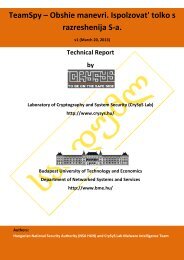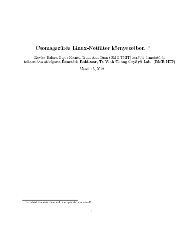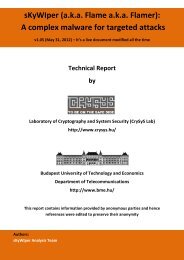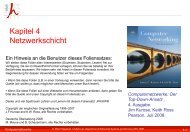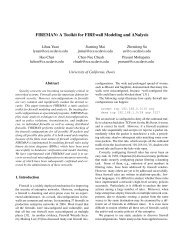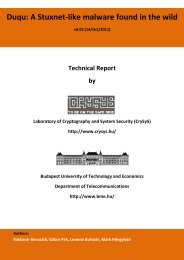You also want an ePaper? Increase the reach of your titles
YUMPU automatically turns print PDFs into web optimized ePapers that Google loves.
Contents<br />
1 Introduction 1<br />
1.1 Introduction to RFID systems . . . . . . . . . . . . . . . . . . . . . . . . . . . . . . 2<br />
1.2 Introduction to Vehicular Ad Hoc Networks . . . . . . . . . . . . . . . . . . . . . . 3<br />
1.3 Introduction to Wireless Sensor Networks . . . . . . . . . . . . . . . . . . . . . . . 4<br />
2 Private Authentication 9<br />
2.1 Introduction to private authentication . . . . . . . . . . . . . . . . . . . . . . . . . 9<br />
2.2 Resistance to single member compromise . . . . . . . . . . . . . . . . . . . . . . . . 11<br />
2.3 Optimal trees in case of single member compromise . . . . . . . . . . . . . . . . . . 14<br />
2.4 Analysis of the general case . . . . . . . . . . . . . . . . . . . . . . . . . . . . . . . 20<br />
2.5 The group-based approach . . . . . . . . . . . . . . . . . . . . . . . . . . . . . . . . 23<br />
2.6 Analysis of the group based approach . . . . . . . . . . . . . . . . . . . . . . . . . 24<br />
2.7 Comparison of the group and the key-tree based approach . . . . . . . . . . . . . . 26<br />
2.8 Related work . . . . . . . . . . . . . . . . . . . . . . . . . . . . . . . . . . . . . . . 27<br />
2.9 Conclusion . . . . . . . . . . . . . . . . . . . . . . . . . . . . . . . . . . . . . . . . 28<br />
2.10 Related publications . . . . . . . . . . . . . . . . . . . . . . . . . . . . . . . . . . . 28<br />
3 Location Privacy in VANETs 29<br />
3.1 Introduction . . . . . . . . . . . . . . . . . . . . . . . . . . . . . . . . . . . . . . . . 29<br />
3.2 Model of local attacker and mix zone . . . . . . . . . . . . . . . . . . . . . . . . . . 31<br />
3.2.1 The concept of the mix zone . . . . . . . . . . . . . . . . . . . . . . . . . . 31<br />
3.2.2 The model of the mix zone . . . . . . . . . . . . . . . . . . . . . . . . . . . 32<br />
3.2.3 The operation of the adversary . . . . . . . . . . . . . . . . . . . . . . . . . 32<br />
3.2.4 Analysis of the adversary . . . . . . . . . . . . . . . . . . . . . . . . . . . . 32<br />
3.2.5 The level of privacy provided by the mix zone . . . . . . . . . . . . . . . . . 34<br />
3.3 Simulation of mix zone . . . . . . . . . . . . . . . . . . . . . . . . . . . . . . . . . . 34<br />
3.3.1 Simulation settings . . . . . . . . . . . . . . . . . . . . . . . . . . . . . . . . 34<br />
3.3.2 Simulation results . . . . . . . . . . . . . . . . . . . . . . . . . . . . . . . . 35<br />
3.4 Global attacker . . . . . . . . . . . . . . . . . . . . . . . . . . . . . . . . . . . . . . 36<br />
3.5 Framework for location privacy in VANETs . . . . . . . . . . . . . . . . . . . . . . 37<br />
3.6 Attacker Model and the SLOW algorithm . . . . . . . . . . . . . . . . . . . . . . . 38<br />
3.7 Analysis of SLOW . . . . . . . . . . . . . . . . . . . . . . . . . . . . . . . . . . . . 39<br />
3.7.1 Privacy . . . . . . . . . . . . . . . . . . . . . . . . . . . . . . . . . . . . . . 39<br />
3.7.2 Effects on safety . . . . . . . . . . . . . . . . . . . . . . . . . . . . . . . . . 44<br />
3.7.3 Effects on computation complexity . . . . . . . . . . . . . . . . . . . . . . . 44<br />
3.8 Related work . . . . . . . . . . . . . . . . . . . . . . . . . . . . . . . . . . . . . . . 44<br />
3.9 Conclusion . . . . . . . . . . . . . . . . . . . . . . . . . . . . . . . . . . . . . . . . 46<br />
3.10 Related publications . . . . . . . . . . . . . . . . . . . . . . . . . . . . . . . . . . . 47<br />
xi



